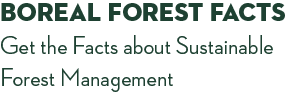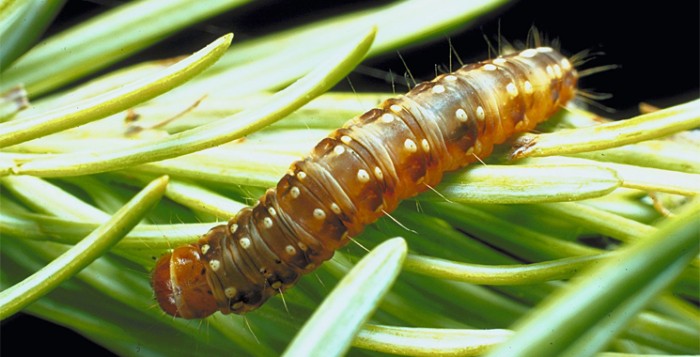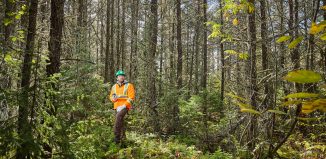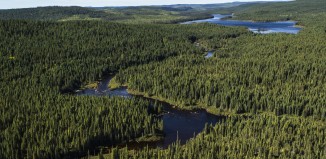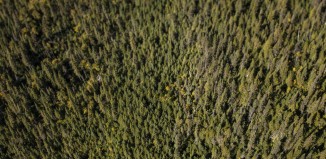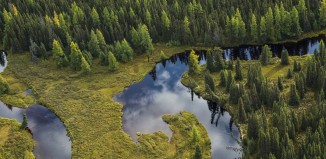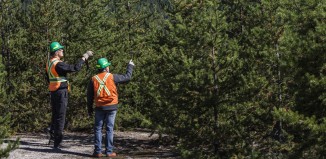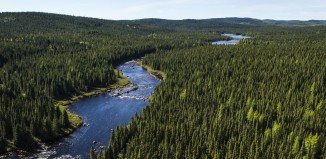11 Big questions about the tiny Spruce Budworm
1. What is the spruce budworm and where does it come from?
The spruce budworm is a native North American insect whose caterpillar measures about 20 to 30 millimeters and is a voracious eater of conifer needles, specifically, those of white, red and black spruce as well as balsam fir. It is found in all of Canada’s provinces and in the United States.
The larvae overwinter in small silk cocoons and emerge in the spring at only 1.5 millimetres long to feed on flower pollen as they wait for buds to open. When new shoots appear, the larvae form a second cocoon-like shelter and feed off the shoots until late June when they mature into larger caterpillars. These mature budworms are responsible for 85% of all needle loss, or defoliation, caused by the insect. Over three to five years, an infestation will kill the crown of the tree, if not the entire tree.
2. How does the spruce budworm kill a tree?
The spruce budworm eats the tree’s needles and new shoots. It usually attacks near the top of the tree and also eats the buds that are responsible for a branch’s new growth.
The spruce and fir trees that are common budworm targets accomplish much of their growth from season to season through what is called a central top leader. The top leader supresses outward growth and helps maintain the tree’s pyramid shape. If this top leader is damaged, the health of the tree will suffer.
And if the buds responsible for new growth are eaten, there won’t be any subsequent growth on an old wood branch and it will eventually turn into a stub that won’t grow anymore. Over three or four years of defoliation, this is how a tree loses its vitality. Five to seven years of this type of defoliation will kill the entire tree.
3. When did the current outbreak start in Quebec?
This outbreak began slowly in 1992 but researchers saw a rapid rise in the spruce budworm population in 2006. Since then, some 4 million hectares of Quebec forest have been affected – that’s an area the size of Switzerland.
4. What caused this outbreak?
The availability of extensive forests of susceptible host trees is a primary contributor to the development of widespread outbreaks, according to Natural Resources Canada. This is mostly because these stands support the survival of small budworm larvae and the maturation of moths that will reproduce and migrate to new areas.
There are two schools of thought on what causes an outbreak. One says that budworm populations increase first in areas where natural enemies can’t offset the local density of budworms. The reproductive success of budworms then increases and migrating moths move to new areas adding eggs to grow those local populations. This leads to a rise in spruce budworm populations over a very wide area.
But other research indicates that outbreaks are not triggered by any specific phenomena and don’t originate at specific sites. Rather, budworm populations fluctuate naturally and constantly. Outbreaks, then, are simply cyclical fluctuations. Regardless of the cause, these recurring widespread spruce budworm outbreaks are greater threats to the boreal than other insects, fire or disease.
5. Is the spruce budworm limited to Quebec?
No. It is found in all provinces across Canada as well as in the United States. And there is some indication that this outbreak is spreading farther east, to New Brunswick and Nova Scotia.
6. How does this outbreak compare to others we have experienced?
The last three major budworm outbreaks, in 1910, 1940 and 1970, manifested themselves over successively larger areas. At this stage, our current outbreak is smaller than the last one. The last major outbreak, which lasted from 1970 to 1987, adversely affected 58 million hectares of boreal forest. The current outbreak, which began in 1992, saw its rate of spread accelerate in 2006, mainly in the regions of Côte-Nord and Saguenay-Lac-Saint-Jean. From 2006 to 2014, the infested area grew from 50,000 hectares to more than 4 million. In the last three years, the infested area increased by nearly 62%. And 45% of it is considered to be in a state of severe defoliation, where most of the trees have lost their foliage throughout the length of the crown.
7. Can trees killed by spruce budworm still be useful?
Yes. Dead trees can still be harvested and used for pulp, but it takes more of this infected wood to make a tonne of newsprint, and the process is more expensive. The poor quality fibre from the infected trees must be bleached to remove stains from the budworm and ensure an acceptable paper quality. So while trees can be used, the relative cost of harvesting, processing and production decreases the competitiveness of an operation. And when you factor other fixed costs such as labour and energy, having to use poor quality fiber can play a role in the long term viability of a facility.
8. Can’t we just spray forests with an insecticide?
Yes, but it’s expensive and it can be difficult to predict outbreak areas and know where to spray. Since 1987, the only insecticide that may be used in Quebec against the spruce budworm is a naturally occurring and environmentally safe bacterium called Bacillus thuringiensis.
B.t., as it is sometimes known, is a host-specific pathogen that affects only the larvae of lepidopterous insects, where it paralyzes the digestive system and kills the organism. This method is used to control a variety of other agricultural pests, like leaf beetles, as well as other annoying insects, like mosquitoes and black flies.
In the case of spruce budworm infestations in the boreal forest, B.t. application costs have ballooned from $4 to $10 per hectare in the 1970s and 1980s to more than $65 per hectare as of 2012. So spraying is generally reserved for high value or high risk stands.
9. When will this outbreak end?
Outbreaks tend to occur every 20 to 40 years as part of a natural spruce budworm population cycle. It is generally understood that an outbreak ends when the amount of damaged trees can no longer support the budworm population. This is often combined with a rise in budworm mortality caused by its natural enemies like birds or spiders but the most important are parasitoids. The different species attack different stages of the budworm (the egg, pupae, or larger larva).
10. What is being done to control future spruce budworm outbreaks?
Most of the work right now is focused on carefully monitoring the budworm population to watch for fluctuations. Using a network of permanent observation stations, researchers can measure population sizes and can also predict short- and medium-term trends.
Since 2011, Canadian Forest Service researchers at the Laurentian Forestry Centre have been studying these issues in the Lower St. Lawrence region and in two endemic populations near Québec City. The objective of this project is to observe the dynamics of budworm populations during the upward phase of a new outbreak over the broadest possible density range.
New early intervention methods that target infection epicenters to prevent large-scale progression have been proposed. To improve stand resistance to the budworm, foresters are looking at increasing the species diversity and carrying out commercial thinning in outbreak-free areas.
11. What is the economic impact of this outbreak so far?
While it is too early to measure the economic impact, it is estimated that the last budworm outbreak adversely affected some 58 million hectares of boreal forest and caused losses in wood supply equivalent to 20 years worth of harvest in Quebec alone.
With respect to the latter, losses resulting from the last spruce budworm outbreak, in Quebec alone, are estimated at ~500 million m3 of spruce and fir, for an estimated commercial value of $12.5 billion.
Insects and pathogens are by far the single largest threat to North American forests. Their destruction affects an area almost 50 times larger than fire and their economic impact is nearly 5 times as great11.
For more information, visit Natural Resources Canada and SOPFIM, Quebec’s forest protection agency.
Image source:
http://en.wikipedia.org/wiki/Choristoneura_fumiferana#mediaviewer/File:Choristoneura_fumiferana_larva.jpg
Additional Sources:
1. http://www.ontario.ca/environment-and-energy/spruce-budworm
2. http://www.cbc.ca/news/canada/montreal/quebec-spruce-budworm-link-to-climate-change-being-studied-1.2705081
3. http://www.sprucebudworm.ca
4. http://www.nrcan.gc.ca/forests/insects-diseases/13383
5. http://www.nrcan.gc.ca/science/video/11724
6. http://www.nrcresearchpress.com/doi/pdf/10.1139/x95-150
7. http://sopfim.qc.ca/admin/datas/pdf/PDF_06_EN.pdf
8. http://www.entomology.umn.edu/cues/Web/202SpruceBudworm.pdf
9. http://www.cals.uidaho.edu/edcomm/pdf/bul/bul0644.pdf
10. http://www.ext.colostate.edu/pubs/insect/05556.html
11. http://izt.ciens.ucv.ve/ecologia/Archivos/ECOLOGIA_DE%20_POBLACIONES_Hasta%202004/ECOL_POBLAC_Hasta%202004_(H-N)/Logan%20y%20col%202004.pdf
